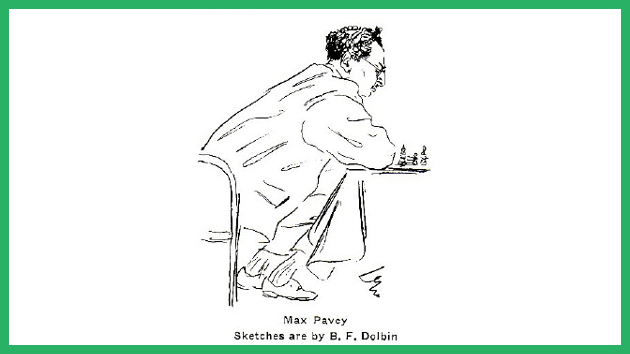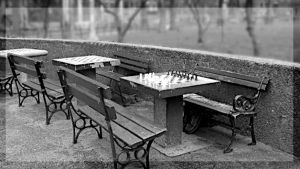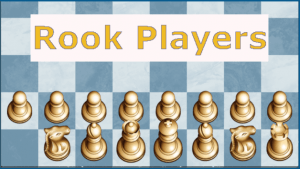
Pavey
From September 2-21, 1957 the first International Women's Team Tournament (i.e. the first Women's Chess Olympiad) took place in Emmen, Holland. The U. S. team, comprised of Gisela Gresser and Jacqueline Piatigorsky, came in 10th out of the 21 countries participating. Even so, both ladies won the third place medals, Gresser on bd. 1 and Piatigorsky on bd. 2., both with scores on +6=4-2. The USSR won the tournament. The American team failed to make it to the finals, but came in first in the Group A consolation tourney.
Playing the tournament was difficult but only part of the story.
Setting up the tournament involved logistics and coordination among the nations. In the U.S., the negotiations for the American team were all in the hands of Max Pavey.
By day Max Pavey was a chemist and plant manager at the Canadian Radium and Uranium Corp. Laboratory in Mt Kisco, N.Y. but in his spare time, a chess master USCF (Senior Chess Master) and chairman of the USCF International Affairs Committee.
 1956
1956
Two days after the Women's Team Tournament started, Pavey died. Pavey had been sick for quite some time with both leukemia and heart problems.
Nine days later, on Nov. 13, 1957, it was reported:
Mt. Kisco Radium Plant Will Close
A controversial radium processing plant here has decided to close down by next Feb. 15 it was disclosed yesterday. The Canadian Radium and Uranium Corp.. in a letter released by the Westchester county department of health, announced plans to stop importing material and to end operations once all material on hand has been processed, The state labor department recently charged the company violated safety rules and the New York city examiner's office has said that a plant manager, Max Pavey, 39, died of leukemia linked to excessive exposure to radium. Later the department reported steps had been taken to comply with safety regulations. The plant, which uses no fissionable materials, has been reclaiming radium from various materials and reprocessing it for medical purposes. The company letter, signed by Dr. Boris Preget, president of the firm, denied that the plant was a danger to the community, saying: "This refinery always operated absolutely on the level with absolutely no danger whatsoever... " He said the reason for the decision to close the plant was "purely economic." He added that the decision was made about a year ago, because the plant had been "a losing operation for the last seven years."
One month later:
Pavey had been confined to Mt. Sinai for some time and conducted his negotiations, the last of which he would ever perform, for the Women's Team Tournament from his hospital bed.

1949
Max Pavey was from N.Y. where he played collegiate chess for the City College team. He moved to Scotland in 1938 to study medicine at Anderson College in Glasgow where he was at the top of his class. The following year he won the Scottish national chess championship in Aberdeen i(April 1939). Two months later he went home for the summer but the war intervened making any thought of returning to Scotland implausible.
After the war and back in the U.S., his chess career accelerated. He won U.S. Lightning Championship in 1947 and the New York State Championship in 1949 , both the Manhattan C.C. Championship and the U.S. Speed Championship in 1953. He also earned his M.S. degree from Brooklyn College.
He had some other, more minor, successes in chess and a few in Bridge (he was on the Board of Directors of the Greater New York Bridge Association). He also served as vice-president of the USCF.
Pavey was also an important, if passive, piece in the puzzle known as Bobby Fischer. On January 17, 1951, as a result to a postcard from Regina Fischer to Hermann Helms, Bobby Fischer was invited to take part in his first public game, a simul given by IM Max Pavey. While Fischer later credited Pavey's performance as a motivational force in his early chess career, more importantly, one of the spectators at this simul was Carmine Nigro, who saw Fischer's potential and invited him to join the Brooklyn Club. Nigro subsequently became Bobby Fischer's first teacher.
Only 39 when he died, his accomplishments were enough for several long lifespans.
 .
.
Max and Violet Posner Pavey
 Chess Life, April 20 1961
Chess Life, April 20 1961
The City College of New York still offers this award under the name "Max Pavey Scholarship.
A side note:
Many places claim Pavey was a medical doctor, having received his MD in Scotland and refer to him as Dr. Pavey.
He was born in Boston in 1918. and, according to Chess Scotland, "came to Scotland in 1938 to study at the Anderson College of Medicine in Glasgow" and "returned to the USA in the summer of 1939" (during which time he won the Scottish Championship). In 1938, he was only 20 years old. After he returned to the United States, he studied chemistry at Brooklyn College. His obituary claimed that he studied medicine in Edinburgh (as opposed to Glasgow) but did not say he earned a degree. It did , however, mention his Masters of Science degree from Brooklyn College. Everything indicates that he was never a doctor, neither an MD nor a PhD.
Below is a game played between Pavey and Bobby Fischer in 1956 when Fischer was starting to become good (At twelve, I just became good —Bobby Fischer)
.
.
.
Pavey played in the USA-USSR team match when the Soviet team visited NYC in the Summer of 1954. His opponent was Paul Keres. Four games were to be played between matched opponents. Pavey won 1 game off Keres but lost 2 after which he was replaced by the team captain with Alexander Kevitz who lost the fourth game. Below is Pavey's win over Keres:
.
.
.
Below is Pavey's win against a man who was an actual PhD (psychology). Hearst himself just died in September of this year.
.
.
.
The following two games: the first from the U.S. Championship and the second from the U.S. Open.
.
.
.
.
.
.
and finally a spirited game between Pavey and an actual MD (a psychiatrist), Dr. Ariel A. Mengarini
.
.
The cover image was sketched by Benedikt Fred Dolbin.
Dolbin had been a highly successful pre-WWII Austrian illustrator, mainly for newspapers. When Jews were expelled from the Reichspressekammer, he emigrated to the United States where he worked as a draftsman, never achieving his earlier artistic successes.
Some of his other works can be viewed here.






